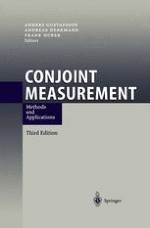2003 | OriginalPaper | Chapter
Confounding of Effects in Rank-Based Conjoint-Analysis
Author : Thorsten Teichert
Published in: Conjoint Measurement
Publisher: Springer Berlin Heidelberg
Included in: Professional Book Archive
Activate our intelligent search to find suitable subject content or patents.
Select sections of text to find matching patents with Artificial Intelligence. powered by
Select sections of text to find additional relevant content using AI-assisted search. powered by
Conjoint analysis enjoys large popularity among marketing researchers, as it combines easy-to-handle data collection with sophisticated evaluation methods. Dating back to the 70th, rank-based conjoint analysis is traditionally used to approximate metric utility functions of individual respondents within its given limits (see overview in: Green and Srinivasan 1978, 1990). This approach constitutes the basis for many past academic research studies and practical applications (Schubert 1991) and thus shapes their findings. Today, rating scales are applied more often (Wittink et al. 1994), partly because of the scale requirements of new methods, such as hybrid models (e.g., Green 1984) or the standardized software package ACA (Green et al. 1991). Accordingly, this paper is intended for those who either (still) apply rank-based Conjoint-analyses or who want to compare their findings with those from past rank-based conjoint studies.
